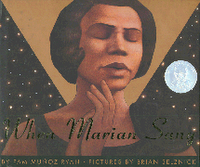WHEN MARIAN SANG: THE TRUE RECITAL OF MARIAN ANDERSON

BIBLIOGRAPHY
Ryan, Pam Muñoz. 2002. WHEN MARIAN SANG: THE TRUE RECITAL OF MARIAN ANDERSON. Ill by Brian Selznick. New York: Scholastic Press ISBN: 0-439-26967-9 Reading level: 6 to 10
PLOT SUMMARY
This is a biography of Marian Anderson. In her early days, Marian liked to sing and her voice was very distinct. She was asked to sing in the choir of the Union Baptist Church located in south Philadelphia. When she wanted to apply to music school, she was turned down because of her race. The book describes this part like this, “she could not understand how anyone who was surrounded by the spirit and beauty of music could be so narrow-minded.” She didn’t give up and continued to take voice lessons in her own neighborhood, and sang in the choir. Marian saw a performance of the Metropolitan Opera, and was very impressed. This performance inspired her to continue studying music. With her friends’ help, she got an opportunity to have an audition with Giuseppe Boghetti. Although she was not accepted to the school, Mr. Boghetti decided to accept her after hearing her voice. In 1927, she went to Europe to gain more advanced experiences, in Europe she felt freer than in America. She gained fame as a singer and even Arturo Toscanini announced that “I was privileged to hear only once in a hundred years.”
After coming back to America, she was asked to perform at Constitution Hall but couldn’t because of the ‘white performers only policy.’ With an approval from President Roosevelt, she could sing in the Lincoln Memorial on Easter Sunday. Surrounded by 75,000 people, she sang beautifully. When she finished, she got a roaring cheer and was asked to encore. Sixteen years after the performance, she finally could debut at the Metropolitan Opera. It was the moment she dreamt about for years.
CRITICAL ANALYSIS
As an Orbis Pictus Award winning book in 2003, this book describes not only the story of prevailing against all odds, it also gives a historic background of the United States in a pre-civil rights stage and there was a wide spreading prejudice against colored people. The book has very clear sentences and a rich language to encourage students, for example ‘their harmony blended like a silk braid.’ Some pages are filled with her lyrics, and this makes me feel like I am watching her sing a song. The brown color tone of the illustrations complements the text well. With the illustrations, readers may notice that when she sang, she always closed her eyes, and she felt a deep sorrow when she was rejected from the music school. The last three pages are filled with some words from the author and illustrator describing where and how they gained information about Marian. In addition, the book includes chronological records of Marian Anderson. It would be useful when students want to know more about her.
REVIEW EXCERPTS
School Library Journal (October 1, 2004)
Interspersed with the spiritual songs she sang and including lengthy author's notes, this picture book traces Marian Anderson's history-making career. Add Ryan's Amelia and Eleanor Go for a Ride (Scholastic, 1999. ISBN 0-590-96075-X) to bring three exceptional women to the classroom. Copyright 2004 Reed Business Information.
Horn Book Guide (April 1, 2003)
This picture-book biography of the American contralto indulges in mythification (although the keynote of the Anderson myth--being kept out of Constitution Hall by the D.A.R.--is here muted), but Marian Anderson's career was significant in both musical and social terms, and Ryan and Selznick get this right. Throughout both the large double-page spreads and text there's an intimacy of tone that gives life to the legend. Copyright 2003 of The Horn Book, Inc. All rights reserved.
CONNECTIONS
Activities
*Let children read various books about Marian Anderson and compare the perspectives which each book has.
Other books about Marian Anderson
*Kaplan, Howard S. et al. Women Who Dare: Marian Anderson 0-7649-3891-6
*Freedman, Russell. The Voice That Challenged a Nation: Marian Anderson and the Struggle for Equal Rights ISBN: 0-618-15976-2
*Tedards, Anne. Marian Anderson ISBN: 1-59155-324-5
*McKissack, Patricia C. et al. Marian Anderson: A Great Singer. Ill by Ned Ostendorf ISBN: 0-89490-303-9





